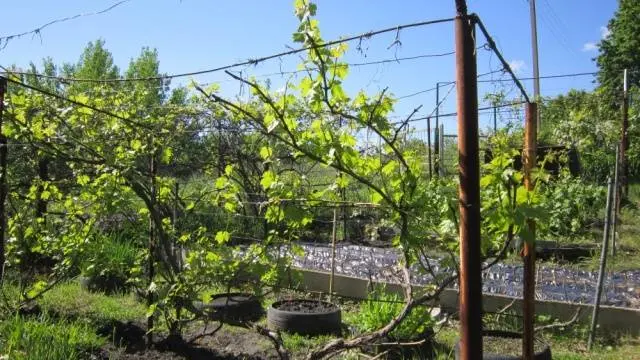Contents
Selection does not stand still, every year scientists bring out more and more new varieties of garden and garden crops. So, relatively recently, breeders from Moldova crossed the Kishmish Pink grapes with the Cardinal variety: as a result, a new species was obtained – Kishmish Radiant grapes. The berries of this variety are large and very beautiful, there are absolutely no seeds inside the pulp, besides this, Radiant Kishmish has a lot of other advantages.

Description of the grape variety Kishmish Radiant, reviews about it, as well as photos can be found in this article. Here are the basic rules for growing and pruning grapevines.
Description
Radiant grapes are considered a table variety, while its distant ancestor, Kishmish ordinary, is suitable only for making juices, wine or raisin production.
The maturation of the variety is medium-early. Radiant got its name because its grapes have a thin skin and light flesh, which are easily penetrated by the sun and seem to glow from the inside.
Characteristics of Kishmish Radiant:
- the ripening period is, on average, 130 days;
- the vine is vigorous, the shoots develop quickly;
- leaves are medium, strongly dissected, five-lobed;
- clusters are large, reach a length of 45 cm;
- the weight of each bunch ranges from 450 to 900 grams;
- the shape of the brushes is conical, the fullness is medium;
- pink berries, elongated;
- the pulp of grapes is fleshy, juicy, dense, with a subtle flavor of nutmeg;
- the taste is sweet and sour, very pleasant and refreshing;
- there are no seeds in the pulp;
- the marketability of grapes is high;
- yield – above average – about 12 kg per bush;
- grapes are harvested at the end of August or in the first decade of September;
- about 65% of Kishmish’s vines are fruit-bearing, this must be taken into account when pruning and shaping a bush;
- the peel of the grapes is quite dense, so the clusters tolerate transportation and storage well;
- You can store the harvest of Radiant Kishmish until January, for this, the clusters are neatly folded into clean wooden boxes and placed in a cool, dry place.

A more detailed description of Radiant grapes can be found in the specialized literature, but for amateur cultivation, the above information is quite enough.
Winegrowers advise growing this variety on special arches or arbors, so that large clusters hang freely, are evenly illuminated by the sun and blown by the wind. Under such conditions, Kishmish will not be affected by fungal infections that are dangerous for him.
Strengths and weaknesses of the variety
Great plus grapes Kishmish Radiant its high marketability is considered:
- there are no seeds in grapes;
- its pulp is quite dense, sugary, aromatic;
- the skin on the berries is thick, so they rarely crack and are attacked by wasps;
- clusters are large and beautiful;
- the harvest can be stored for a long time, as well as transported over any distance.

The same large size of bunches and high yield of Radiant Kishmish are also disadvantages of this variety. The fact is that the vine is often overloaded, and this, in turn, entails the loss of part of the crop or the loss of the taste of grapes.
If the pruning was done incorrectly, the shoots will be overloaded, the vine will simply break off. Even if the bush survives, numerous berries may not have enough potassium and other trace elements for full ripening. This leads to cracking of the berries, their wateriness, high acidity.
How to grow
Features of growing the Kishmish Radiant variety are based, first of all, on the shortcomings of this grape. Care of the bushes must necessarily include competent and correct pruning.

Trimming
As already mentioned, pruning for this grape variety is a very important component of care. If the clusters are not thinned out in time, then in the first year they can be unusually large – each brush will weigh about 1-1,5 kg. But next season there will be a strong shrinkage of berries and clusters. Do not forget about the high probability that the vine will break and the bush will die.
In order to prevent all these consequences, it is necessary to cut the vine in a timely and correct manner, to be guided in this matter by diagrams and photos. The distribution of the load on the bush should be as follows: 1-2 bunches of grapes for each fruit shoot, which will eventually amount to 50-60 tassels per adult Radiant bush.
If you follow such a simple scheme, in the fall or at the end of summer you can harvest a good harvest of half a kilogram bunches of high commercial quality.

The basic rules for the formation of grape bushes Kishmish Radiant are as follows:
- On new sleeves, you need to leave 2-3 eyes.
- All old sleeves should consist of a maximum of 14 eyes.
- The total load on each adult bush should be from 25 to 30 eyes.
- The distance between adjacent sleeves should be at least a meter. To achieve this, the vigorous Kishmish Radiant is planted at intervals of 2,5-3 meters with neighboring bushes or other plants.
- It is necessary to form bushes of this variety according to the scheme with the largest supply of wood.
- Weak or diseased shoots are subject to mandatory pruning – you should not overload an already loaded bush.

Features of care
A wine grower who has chosen the Radiant variety for cultivation will not be able to rest – this variety of Kishmish needs constant and very careful care.
The method and intensity of irrigation largely depend on the composition of the soil and the type of climate in a particular region of the country. In any case, Kishmish responds well to drip irrigation, so it is recommended to install such irrigation systems under the vine. You should not water the bushes during the flowering and ripening of berries, and you should also stop watering 2-3 weeks before the upcoming harvest.

The frost resistance of this grape is weak (the vine can only withstand temperatures down to -15 degrees), so in most regions of Our Country the vine will have to be covered for the winter. To save the grapes from frost, the vine is cut in the fall, then tied and bent to the ground.

After that, each owner acts in his own way: someone pours an earthen mound over the vine, others use spruce branches or spruce needles, you can cover the grapes with special non-woven materials or build a house of slate or boards around it. There is a lot of way to shelter the vines for the winter, usually the choice of a particular option depends on the region and its climatic features.
During the flowering period, Radiant Kishmish must be treated from pests and diseases characteristic of the variety (usually, these are fungi). Kishmish often suffers from mildew and oidium, the variety is also unstable to root phylloxera. You need to regularly inspect the vine and leaves in order to identify diseases in the early stages and take timely action. The clusters should be well ventilated and blown by the wind – you should carefully consider the place of planting the bush.

For example, the nutmeg aroma can be lost if the vine is watered too often and abundantly. The taste qualities of berries also suffer greatly in case of a lack of trace elements in the soil. Often the earth under powerful bushes lacks potassium – it is with this component that Radiant should be fed annually.
In order for Kishmish berries to grow large and healthy, it is recommended to treat the emerging clusters with Gibberellin.

Reviews

We live in the center of the country, so for a long time we did not dare to start Radiant Kishmish in our household, because it does not tolerate frost well. But for five years now, we have been growing this magnificent variety: so far, grapes have only made us happy. I can advise beginner growers to use a short pruning for this variety of Kishmish and not to treat it with growth stimulants (such as gibberellin). As a result of stimulation, individual berries really turn out to be very large, but the rest of the mass turns into “peas”. It is not yet necessary to fill the bushes with water and overdo it with fertilizers, from such actions the clusters become loose and disheveled.
Conclusion
The grape variety is worthy of the attention of any grower. Kishmish Radiant is a rather capricious and fastidious variety: it does not like the cold, requires careful and painstaking pruning, and needs complex care. Many more gardeners are repelled by the fact that in order to get a decent harvest, the vine must be treated with chemicals at least 5-6 times per season.

But after all, no one knows how much and with what the purchased grapes were sprayed. That’s why definitely worth a try and plant Kishmish in your garden – the result will surely please you, because the taste of grapes is really excellent.









